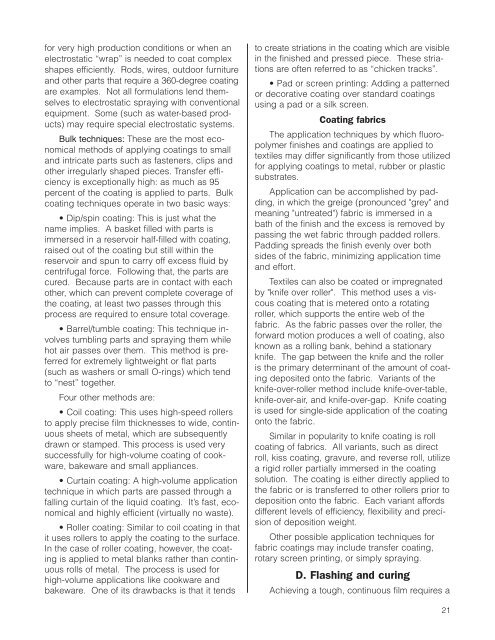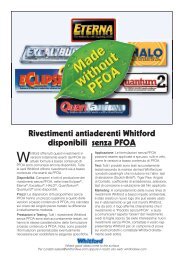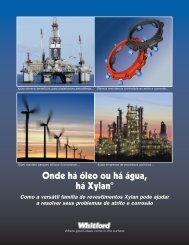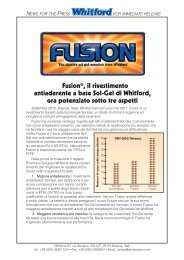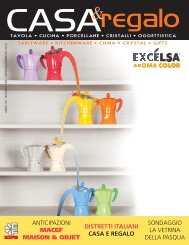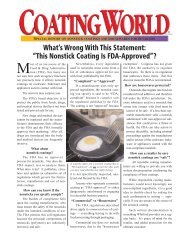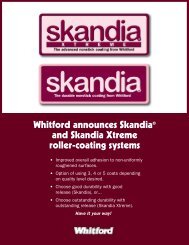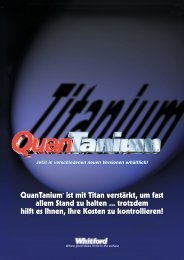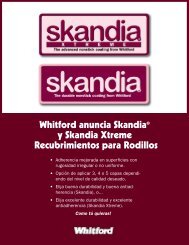Literature PDF
Literature PDF
Literature PDF
- No tags were found...
Create successful ePaper yourself
Turn your PDF publications into a flip-book with our unique Google optimized e-Paper software.
for very high production conditions or when anelectrostatic “wrap” is needed to coat complexshapes efficiently. Rods, wires, outdoor furnitureand other parts that require a 360-degree coatingare examples. Not all formulations lend themselvesto electrostatic spraying with conventionalequipment. Some (such as water-based products)may require special electrostatic systems.Bulk techniques: These are the most economicalmethods of applying coatings to smalland intricate parts such as fasteners, clips andother irregularly shaped pieces. Transfer efficiencyis exceptionally high: as much as 95percent of the coating is applied to parts. Bulkcoating techniques operate in two basic ways:• Dip/spin coating: This is just what thename implies. A basket filled with parts isimmersed in a reservoir half-filled with coating,raised out of the coating but still within thereservoir and spun to carry off excess fluid bycentrifugal force. Following that, the parts arecured. Because parts are in contact with eachother, which can prevent complete coverage ofthe coating, at least two passes through thisprocess are required to ensure total coverage.• Barrel/tumble coating: This technique involvestumbling parts and spraying them whilehot air passes over them. This method is preferredfor extremely lightweight or flat parts(such as washers or small O-rings) which tendto “nest” together.Four other methods are:• Coil coating: This uses high-speed rollersto apply precise film thicknesses to wide, continuoussheets of metal, which are subsequentlydrawn or stamped. This process is used verysuccessfully for high-volume coating of cookware,bakeware and small appliances.• Curtain coating: A high-volume applicationtechnique in which parts are passed through afalling curtain of the liquid coating. It’s fast, economicaland highly efficient (virtually no waste).• Roller coating: Similar to coil coating in thatit uses rollers to apply the coating to the surface.In the case of roller coating, however, the coatingis applied to metal blanks rather than continuousrolls of metal. The process is used forhigh-volume applications like cookware andbakeware. One of its drawbacks is that it tendsto create striations in the coating which are visiblein the finished and pressed piece. These striationsare often referred to as “chicken tracks”.• Pad or screen printing: Adding a patternedor decorative coating over standard coatingsusing a pad or a silk screen.Coating fabricsThe application techniques by which fluoropolymerfinishes and coatings are applied totextiles may differ significantly from those utilizedfor applying coatings to metal, rubber or plasticsubstrates.Application can be accomplished by padding,in which the greige (pronounced "grey" andmeaning "untreated") fabric is immersed in abath of the finish and the excess is removed bypassing the wet fabric through padded rollers.Padding spreads the finish evenly over bothsides of the fabric, minimizing application timeand effort.Textiles can also be coated or impregnatedby "knife over roller". This method uses a viscouscoating that is metered onto a rotatingroller, which supports the entire web of thefabric. As the fabric passes over the roller, theforward motion produces a well of coating, alsoknown as a rolling bank, behind a stationaryknife. The gap between the knife and the rolleris the primary determinant of the amount of coatingdeposited onto the fabric. Variants of theknife-over-roller method include knife-over-table,knife-over-air, and knife-over-gap. Knife coatingis used for single-side application of the coatingonto the fabric.Similar in popularity to knife coating is rollcoating of fabrics. All variants, such as directroll, kiss coating, gravure, and reverse roll, utilizea rigid roller partially immersed in the coatingsolution. The coating is either directly applied tothe fabric or is transferred to other rollers prior todeposition onto the fabric. Each variant affordsdifferent levels of efficiency, flexibility and precisionof deposition weight.Other possible application techniques forfabric coatings may include transfer coating,rotary screen printing, or simply spraying.D. Flashing and curingAchieving a tough, continuous film requires a21


